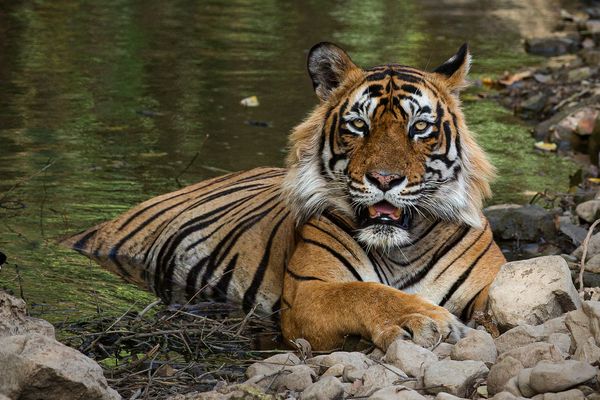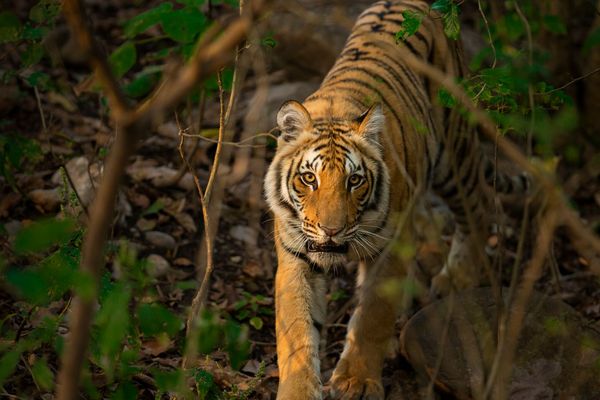Address
304 North Cardinal
St. Dorchester Center, MA 02124
Work Hours
Monday to Friday: 7AM - 7PM
Weekend: 10AM - 5PM
19 Nights / 20 Days
Places to Visit: New Delhi – Leh – Corbett – Agra – Ranthambore – Jaipur – Kanha – Bandhavgarh – Khajuraho – Varanasi


Let’s plan your perfect tiger safari tour in India. Please fill in the details and our representative will get back to you within 24 hours with a custom-made safari tour package.
Or you can reach us via the following.
Our representative will meet you at the New Delhi Airport and ensure a smooth transfer to the hotel. They will also assist you with checking in at the hotel. You will receive and receive explanations of all the documents linked to your travel. Stay the night at the hotel.
Following a satisfying breakfast, check out. Visit Corbett National Park by car. It will take you between five and six hours to go the 275 kilometre distance. You will be greeted upon arrival in Corbett by our personnel, the driver, and the guide. Your stuff will be moved with their assistance to a safari jeep. You’ll be driven there in this jeep, the Dhikala Forest Lodge (approximately 32 km from the gate). After checking in and eating lunch, go on a safari in the Dhikala Zone.
Come back at dusk. Overnight at the Forest Rest House and dinner there.
Visit Corbett National Park and go on a morning and evening safari. At the Forest Rest House, you can take your meals and spend the night.
The land of the roar, trumpet, and song has been accurately described as the Corbett National Park. It depicts a scene of extraordinary beauty. At India, “Project Tiger” was launched in this park. The variety of habitat present in this reserve contributes to its remarkable biodiversity. The reserve contains both Himalayan and peninsular flora and wildlife as a result of its location in the central Himalayan foothills.
Dinners, overnight stays at the Forest Rest House inside the National Park, and morning and afternoon jeep safaris. The first and best park in India is 520 square kilometres large. On August 8, 1936, Sir Malcolm Hailey, the then-governor of the United Provinces, was honoured with the creation of Hailey National Park. In 1952, the name was changed to Ramganga National Park. Jim Corbett, the renowned hunter, naturalist-turned-author, and photographer who had assisted in creating the park and establishing its limits, passed away in 1957, and the park was finally given the name Corbett National Park in his honour and memory.
Check-out after early morning breakfast. Take the 310 km drive to Agra. This should take you about 06 hours. Arrive in Agra by late afternoon. Take the day at leisure. Dinner and overnight at a hotel in Agra.
Visit the Taj Mahal in the morning, a majestic structure that is one of the seven wonders of the world. It was designed by Mughal emperor Shah Jehan as a monument of love for his wife Mumtaz and constructed in the middle of the eighteenth century. In order to build this magnificent mausoleum, which has been immortalised in white Makrana marble and embellished with onyx, amethyst, lapis lazuli, turquoise, jade, crystal, and several other semi-precious stones that were brought from as far away as Tibet, China, and the Indian Ocean, over 20,000 workers from different parts of the world pooled their skills.
Proceed to Ranthambhore after lunch. Visit your safari lodge to check in. After lunch, go on a safari in the late afternoon.
(Note: The Taj Mahal is closed to the public on Friday).
On both dates, take the morning and evening safaris to the Park.
Ten distinct zones make up the entire park, and practically all of them have healthy tiger and animal populations. One of the first National Parks where Project Tiger was launched was Ranthambore. Although the tiger population has fluctuated over the previous century, Ranthambore has experienced a stable period in the last ten years. So much so that it was able to provide Sariska National Park, which was devoid of Tigers due to poaching activities, with a small donation of Tigers.
The committed Forest Department and tourism are solely to blame for Ranthambore’s success and its healthy tiger population.
The Ranthambore Tiger Reserve is located in the Indian state of Rajasthan. It is made up of various discrete regions with varying conservation histories and is essentially geographically isolated from Ranthambore National Park. These mostly include Sawai Mansingh Sanctuary, Keladevi Sanctuary, and Ranthambore National Park.
In addition to being a top destination on the India Golden Triangle Tour & Tiger Safari, Ranthambore is a photographer’s dream. Ranthambore is attractive in its own unique style, with many lighting conditions, viewpoints, backdrops, and frame options. The Park is home to about 300 different bird species, making it rich in avifauna. In reality, Ranthambore and the surrounding area are a birdwatcher’s heaven. Some important species are the Large Cormorant, Painted Spurfowl, Sarus Crane, Bronzed Winged Jacana, Sandpiper, Kingfisher, Nightjar, painted Sandgrouse, Great Horned Owl, and many others that migrate to Ranthambore and the surrounding areas every year from their nesting grounds north of the Himalayas.
With a 400 sq. km. size, Ranthambore includes steep hill crests that drop to wide valleys between the Aravali and Vindhya ranges. This park takes its name from the 1,000-year-old fortress that towers above the forest and is lined with water pools and fruit trees. Ranthambore, which is well renowned for the tiger activity throughout the day, is a very unique and distinctive place where the natural world and human history collide. Languor, Sambar, Cheetal, Chinkara, and Nilgai. In this reserve, visitors have a very excellent chance of spotting tigers when on safaris, as well as the elusive leopard. Ruins of its former splendour, such as chatris or cupolas that resemble palaces or former guard posts, are scattered across the terrain, adding to the area’s romantic and ethereal feel. Meals and lodging at the Resort.
After a leisurely breakfast, check out and then drive to Jaipur. 180 kilometres will be travelled in around three hours. Check into your hotel as soon as you arrive. After a filling lunch, tour Jaipur’s top attractions (Jantar Mantar, Hawa Mahal, City Palace and the Museum). The shopping in this city is very well-known. When you stroll through the “Jaipuri Bazaar,” the culture appears richer than usual, with valuable stones and handicrafts.
Return to the Hotel and spend the evening at leisure.
You should check out of the hotel after breakfast. Visit the Amer Fort, which served as the Rajput Maharajas’ and their families’ previous home. It is a lavish palace with four stories. A hill fort that is also a World Heritage site. After that, travel 275 kilometres in around 5–6 hours to reach New Delhi, the Indian capital.
Transfer to the domestic terminal of the New Delhi Airport early in the morning to catch a flight to Raipur. When you arrive, a member of our staff will welcome you and drive you to Kanha. The distance of this trip, 210 kilometres, will be travelled in roughly four hours.
On arrival check into the resort and after a quick lunch, proceed for afternoon jeep safari. Have your dinner at the resort and stay overnight.
To go on your first early-morning safari to Kanha National Park, get up around 5:00. The 940 sq. km. Kanha Tiger Reserve, established in 1974 as part of Project Tiger, is primarily made up of Sal and Bamboo woods, rolling meadows, and meandering streams. Only in the park can one find the endangered Hard Ground Barasingha (Cervus Duvaceli Branderi).
This is the actual Kipling nation that he eloquently described in The Jungle Book. A predetermined location will have a packed breakfast from the Lodge set out on the Safari vehicle’s bonnet. Enjoy your breakfast while exploring Kanha’s forest. If you haven’t already, keep looking for the elusive tiger while taking in the refreshing and stimulating surroundings. Arrive home from the safari at 11:30. Take a shower and eat lunch.
Depart for afternoon jeep safari at Kanha National Park and return by at 1800 hours. Relax, have dinner, and stay overnight at the lodge.
Visitors can head towards Bandhavgarh National Park after a quick breakfast. You will need to travel 280 kilometres and should allow yourself six hours. The visitor can check in at the hotel upon arrival. After an afternoon safari in the park, continue to the lodge for dinner and the rest of the night.
Freshen up after your morning safari. After a leisurely lunch, continue for an afternoon safari into Kanha National Park’s wilds.
Experience the morning and evening safaris. Relish all meals and stay overnight at the lodge.
The main reason for Bandhavgarh’s fame is the size of its tiger population. Leopards, Blue Bulls, Indian Gaur (Bison), Chausingha (Four Horned Antelopes), Spotted Deers, Sambar Deers, Wild Boar, Sloth Bears, Fox, Jackals, Wild Dogs, etc. are some of the other wild animals in the park. The Park is home to 250 different bird species and at least 22 different mammal species. Along with these species, Ratel, Porcupine, Small Indian Civet, Palm Squirrel, Lesser Bandicoot Rat, Jungle Cat, and Shy Hyenas can also be found in Bandhavgarh. Cobras, Kraits, Vipers, Rat Snakes, Pythons, Monitor Lizards, and Turtles are among the park’s reptile residents. Bandhavgarh is home to the Rhesus macaque and the Hanuman langur, two kinds of primates.
After the morning and evening safaris at the park, savor the taste of all your meals and stay overnight at the park.
After breakfast, take a morning wildlife drive in the national park and travel to Khajuraho. It will take you roughly six hours to drive the 280 km total distance on the tour. Check into the hotel upon arrival. Khajuraho city tour in the future.
The accidental discovery of Khajuraho is India’s second-largest tourist destination. The largest collection of mediaeval temples can be found in Khajuraho, and they are all decorated with countless sculptures of amazing grace and delicacy honouring the stylized and elegant courtly triumphs of beauty, love, and the arts. The temples in the city date from 950 to 1050 AD, when it served as the Chandela Rajputs’ spiritual centre. The area is surrounded by a wall with eight gates, each with two golden palm trees on either side.
The Khajuraho temple complex, which honours Hindu religious thinking in all of its baffling diversity and inclusivity, distinguishes out from the other Hindu temples. The religious veneration of “Yoga” and “Bhoga” is highlighted by the temples. Yoga is the union of the self with the All-Powerful, and Bhoga is the route to God by sensual pleasure. Khajuraho’s temples, which are devoted to sensual love and pleasure, are evidence of this worldview. Khajuraho, which was named a World Heritage Site in 1986, is a well-known, must-visit location, and its temples are India’s special gift to the world since they depict life in all of its forms and moods in stone. Khajuraho’s evening Sound and Light Show. Spend the night in the Khajuraho hotel.
Visit the Eastern and Southern set of temples in the morning after breakfast. The largest Jain temple in the Eastern group is called Parasvanath. The themes show routine daily life in delightful detail. Visit the Chaturbhuj temple of the Southern group and the Shiva-dedicated Kandariya Mahadev temple as well.
Transfer to the airport in the afternoon to catch a flight to Varanasi. depart for Varanasi from Khajuraho. At the Varanasi airport, you will be met and assisted before being driven to your accommodation.
One of the most significant pilgrimage destinations in India and the holiest city for Hindus is Varanasi. Varanasi, also known as Kashi and Benaras, is one of the oldest continuously inhabited towns in the world and has been a hub of study and culture for more than 2000 years.
Visit the Ganga River’s “Ghats” in the evening. This tour is remarkable because you can see how the religious live according to their cultural ethos. Be sure to see the rites done in honour of the setting sun and the riverside purifications. You will witness other boats carrying religious people who are performing ceremonies along the river as they drift downstream, some carrying commodities, fruits, and vegetables.
On the banks, or “ghats,” you can witness people engaged in business, prayer, and hymn chanting, as well as others doing things like shaving, massaging, and even cleaning ears! Cross over to the Manikarnika Ghat to witness cremation being carried out with great ceremony as the deceased person’s soul is sent up to the sky. Hindus hold that Varanasi serves as the entrance to the Heavens and the opportunity for reincarnation of the soul “in a better state.” Overnight in Varanasi.
Early in the morning: Sail along The Ganges, India’s holiest river, at dawn. With pilgrims kneeling in the water at the holy river at sunrise, it is a serene and stunning sight to see. View the city’s patron god, Shiva’s, famous Vishwanath temple, which has spires plated in gold. Breakfast at the hotel; go back there.
Visit Sarnath as well, a city in Uttar Pradesh, India, 13 kilometres to the northeast of Varanasi, close to the meeting point of the Ganges and the Gomati rivers. The Buddhist Sangha was founded in the deer forest near Sarnath, where Gautama Buddha first taught the Dharma after Kondanna attained enlightenment. Shreyansanath, the eleventh Tirthankara of Jainism, was born in Singhpur, a village about one kilometre away from the spot, and there is a shrine there that is dedicated to him. Varanasi, spend the night.
Morning free for relaxation and packing. After that, transfer to the airport for a 10:15 a.m. flight to New Delhi. Arrive at 11:50 a.m. in New Delhi. Met at the airport, transferred to a nearby hotel for a quick shower and change, then transferred to the international airport to catch a flight back home or to another location.
2 August 2022
Amazing experience working with Ishana and all the guides. We saw a ton of tigers in close range. The food and lodging was amazing. Perfect trip and first time in India.
2 August 2022
Excellent Experience with Nature Safari India. Nature Safari India organized our private 2 Weeks Safari in Central India plus a couple of Sightseeing and we are very happy to having choose this agency.
2 August 2022
Deepkul and the Tiger Safari India team put together an incredible experience for us in Kanha and Bandhavgarh. All the details were taken care of as per our preferences and budget including transportation, etc.
15 Days / 16 Nights
The Tiger Safari and Golden Triangle Tour brilliantly captures India’s inherent beauty in a nutshell, combining a culturally attractive environment with the royalty of the tiger…
12 Days / 13 Nights
Tiger Photographic Safari Tour: With the overwhelming diversity at one’s disposal, keeping a bag full of additional batteries and memory cards for your camera is a vital must.
17 Days / 18 Nights
Nestled over an area of around 800 square feet among the Aravali Hills. The Sariska National Park, now known as The Sariska Tiger Reserve, spans kilometres of grasslands…
Contact Us
Nature Safari Pvt Ltd. 51, B-3, Sector-11, Rohini, New Delhi-110085 (India)
Phone
Deepkul Chhetri :+91-9144200272
Explore Indian Tiger Safari Tours
